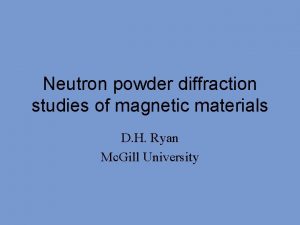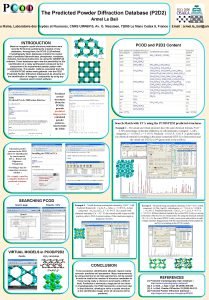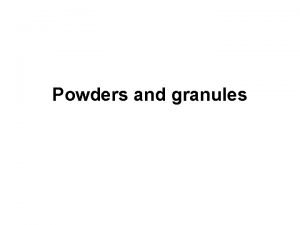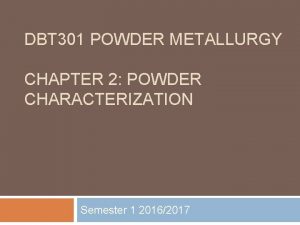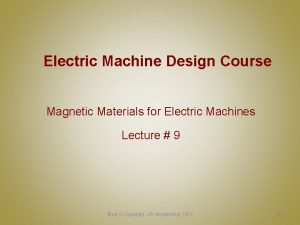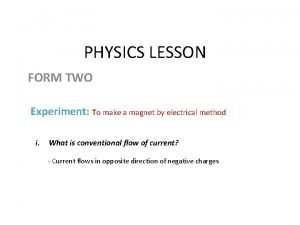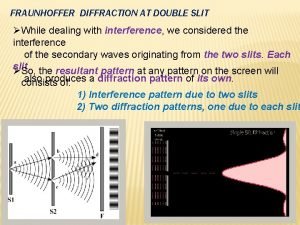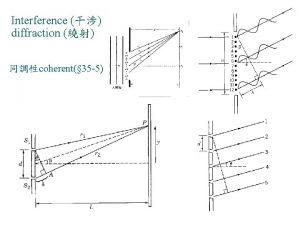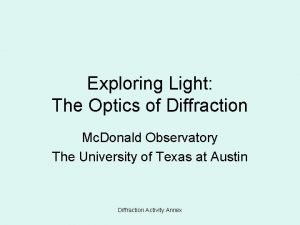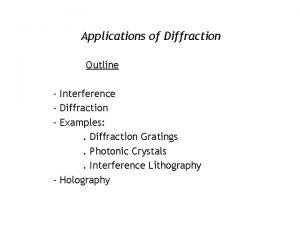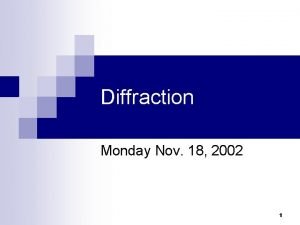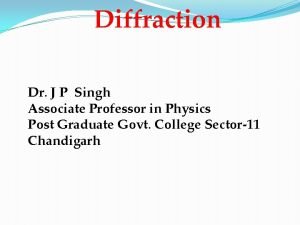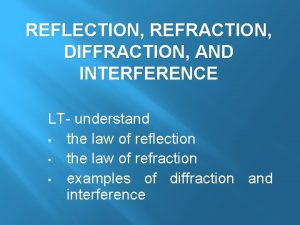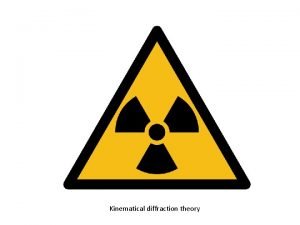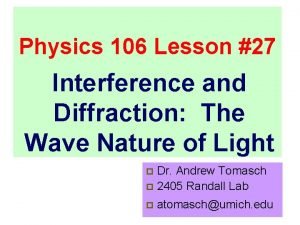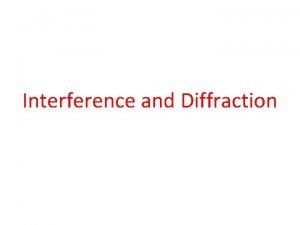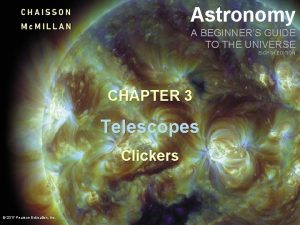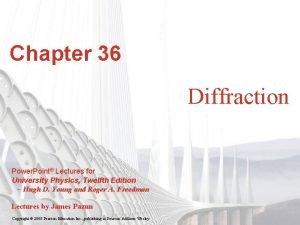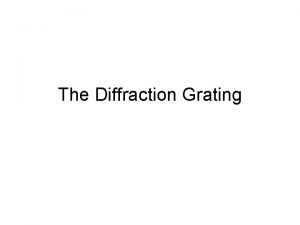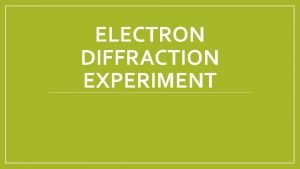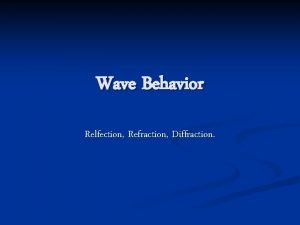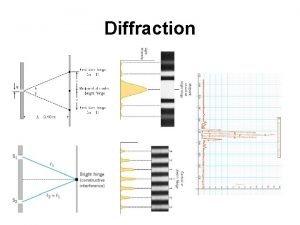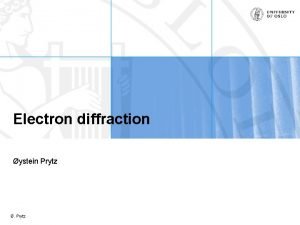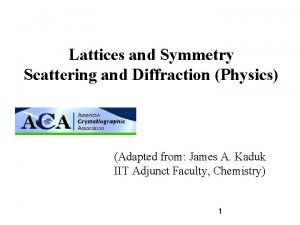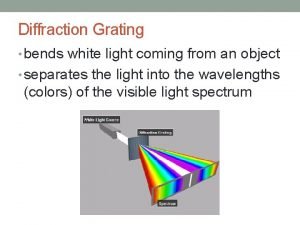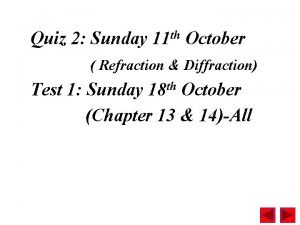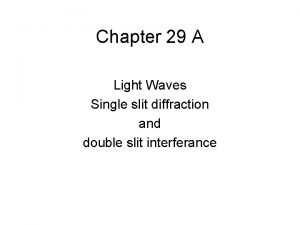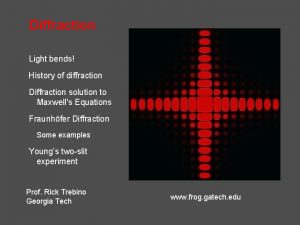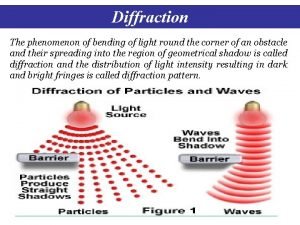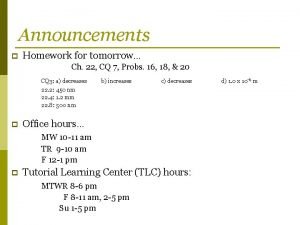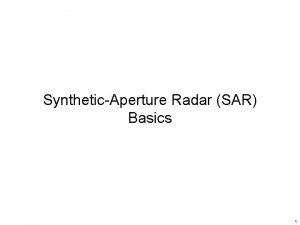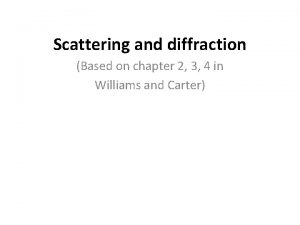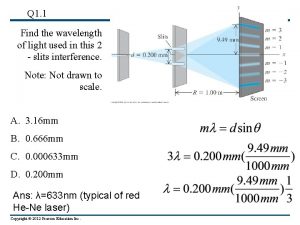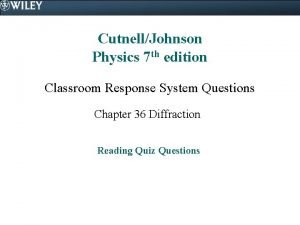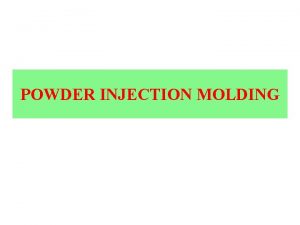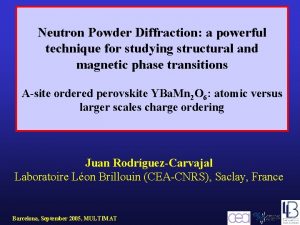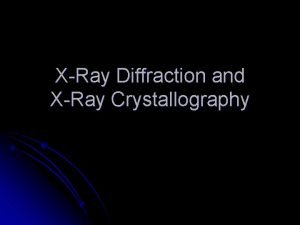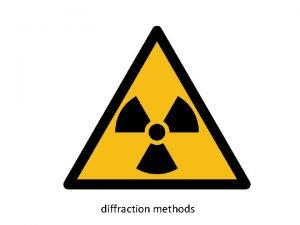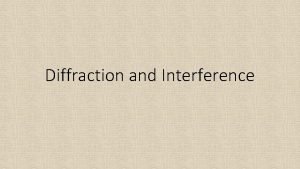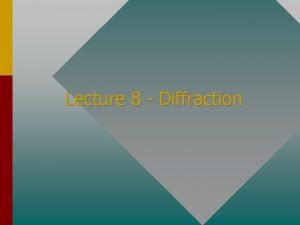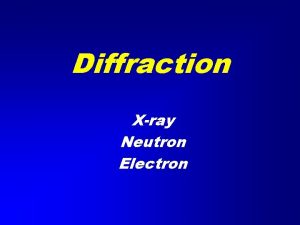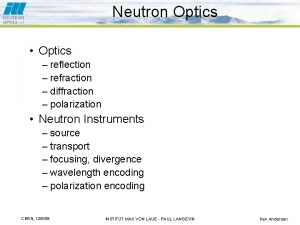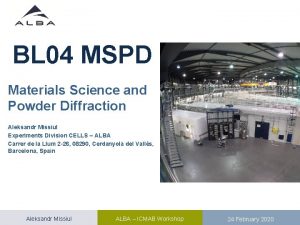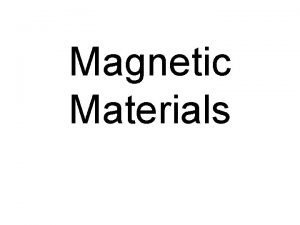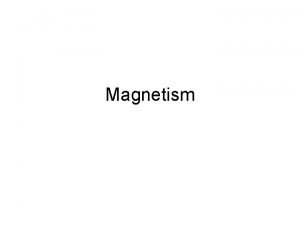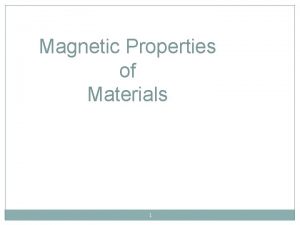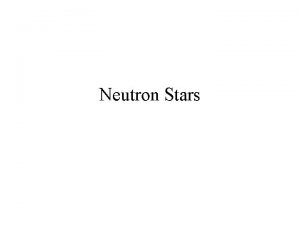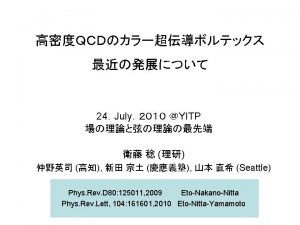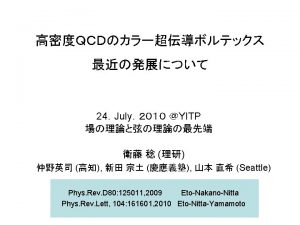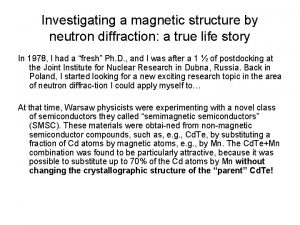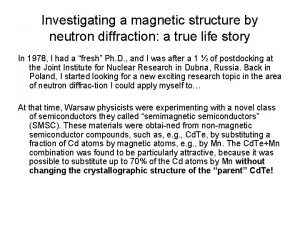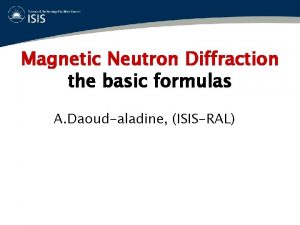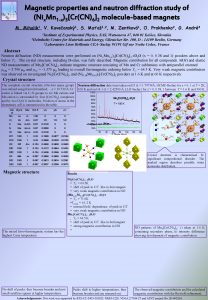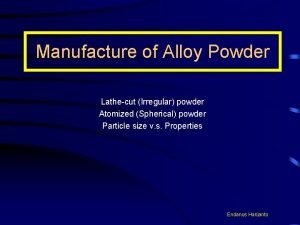Neutron powder diffraction studies of magnetic materials D









































![• Yb [0. 85 1. 08 0] μB 1. 37 (7) μB • • Yb [0. 85 1. 08 0] μB 1. 37 (7) μB •](https://slidetodoc.com/presentation_image/2a4cf04be9faa1f07a3d69bffd50d2cb/image-42.jpg)


![Dy 3 Ag 4 Sn 4: Confirmation • Analysis of the derived magnetic structure[†] Dy 3 Ag 4 Sn 4: Confirmation • Analysis of the derived magnetic structure[†]](https://slidetodoc.com/presentation_image/2a4cf04be9faa1f07a3d69bffd50d2cb/image-45.jpg)






- Slides: 51

Neutron powder diffraction studies of magnetic materials D. H. Ryan Mc. Gill University

Neutron scattering Many features of thermal neutrons make them ideal for crystal structure determination: 1. 2. 3. 4. 5. Weakly interacting Penetrating Non-destructive Wavelength matches lattice spacing Light/heavy element sensitivity

Magnetic neutron scattering • The neutron also has a magnetic moment – this means that it can scatter from other magnetic moments in the sample. • The magnetic scattering length is comparable luck. to the nuclear scattering length No deep. Justphysics here. – this means that the magnetic and nuclear signals have comparable strengths.

Magnetic structure determination • Everything that you have heard about crystal structure determination applies equally to magnetic structure determination. • The neutron scattering pattern observed for a magnetic material is just the Fourier transform of the nuclear and magnetic structure. • In principle, everything that you can learn about the crystal structure can also be learned about the magnetic structure. • The same basic analysis principles are followed. Even the same programs are used

Magnetic structure determination • Neutron diffraction is the best way to study magnetic ordering. • Should always be combined with complementary methods to obtain a more complete picture Examples include: • Bulk magnetic methods (magnetisation, susceptibility) • Mössbauer spectroscopy • NMR • μSR • TDPAC

Some key differences • Magnetic scattering involves the interaction of the neutron’s magnetic moment with that of an atomic electron → EM not strong interaction • Both the nature of the scattering and the object that the neutron scatters from are different. • The form of the scattering is therefore quite different.

Magnetic form factor • Nuclear scattering involves the interaction of a neutron with a point-like (much smaller than the wavelength) object – the nucleus – so the scattering is isotropic. • Magnetic scattering involves the interaction of a neutron with the extended atomic electron distribution, so the form factor is more like that seen for x-ray diffraction, and it falls off quite rapidly with angle. • Unfortunately, the situation is actually worse than it is for xrays as the coherent magnetic scattering comes ONLY from the electrons that contribute to the net moment on the atom, and these tend to be in the outer shells (3 d, 4 f…)

Magnetic form factors

Magnetic form factors The loss of higher-angle magnetic scattering is not normally a problem for magnetic structure determinations: 1. The underlying crystal cell is normally known 2. The magnetic cell cannot be smaller than the crystal cell, so we do not expect to be looking for new high-angle reflections 3. The magnetic cell is frequently much larger than the crystal cell, so we find new peaks at low angles where the form factor is not an issue 4. Some quick-and-dirty fits to the nuclear structure can be obtained by considering only the high angle data where the magnetic scattering should be absent…

New scattering rules • Magnetic scattering of a neutron by an atomic moment involves the EM interaction between the neutron moment P (a vector) with the atomic moment μ (also a vector) and leads to a change in the momentum of the neutron κ (yet another vector) This is clearly going to be more complex than the simple point-on-point nuclear scattering!

It is convenient to define a magnetic interaction vector q as: q = κ × (μ × κ) with |q| = sin α where α is the angle between κ and μ. The differential magnetic neutron scattering cross section per atom can then be written as: This is zero when α is zero, i. e. when the atomic moment and the scattering vector are parallel to each other.

Selection rules • Only the component of the atomic moment that is perpendicular to the scattering vector contributes to the magnetic scattering. • Components of the atomic moments that are perpendicular to the neutron polarisation (neutron moment) also cause the neutron moment to flip – “spin-flip scattering”.

Start with a simple example: Mn. F 2 • Mn. F 2 adopts a tetragonal crystal structure (a = b > c, all angles 90°). • Just two species (Mn and F), only one of which (Mn) carries a moment. • Simple magnetic structure: corner Mn moment “up”, body-centre Mn moment “down” – an antiferromagnet. • TN is 67 K so it is easy to study. • Mn moment is 5μB, so the magnetic scattering is strong.

Magnetic scattering from Mn. F 2 • It immediately clear that the magnetic signal is large! • If we consider a (fictional) “ferromagnetic” form with the Mn moments along c, all of the Mn moments point the same way, so they are equivalent, and the magnetic scattering comes from a bct arrangement of moments. • Kittel tells us that the structure factor for bcc (or bct) requires h+k+l=2 n, and that is what we see.

Magnetic scattering from Mn. F 2 • All of the new, strong reflections fit the h+k+l=2 n rule. • What about the absences? • Most can be understood as violations of the h+k+l=2 n rule. • But what about the (002) reflection? • The peak intensities and pattern tell us about both the symmetry and the direction of the ordering.

Antiferromagnetic order in Mn. F 2 • • • The clearest effect of the c-axis AF order is the appearance of the (100) reflection. The “down” Mn moment in the body centre position is not equivalent to the “up” Mn moment in the cell corner, so the magnetic structure is not bodycentred and the h+k+l=2 n rule does not apply. The (001) reflection is absent because the moments are parallel to the c-axis.

Beyond the simple picture (I) • With one magnetic species and only two magnetic atoms in the cell, Mn. F 2 is a particularly simple case. • Our simplistic description cannot easily extend to more complex situations, and cannot begin to accommodate the realities of magnetic ordering.

Describing magnetic structures • The most important change is that we replace point atoms with vector moments, as we must consider both the location and the orientation of the moments in order to fully describe a magnetic structure. • The underlying crystal lattice is (in principle) unchanged, and the moments simply decorate a sub-set of the lattice points. • The symmetry operations that were developed to describe the crystal space groups are not quite sufficient to describe magnetic ordering, as the moment vectors are axial vectors arising from current loops, and not the more common polar vectors that simply indicate a direction.

Axial vs. polar vectors • Simple operations like translations (t) and 2 -fold rotations (2) act the same way on axial and polar vectors. • However, an inversion centre (i) does not reverse the sense of a current loop and so although it would flip a polar vector, an axial vector is not affected. • Conversely, a mirror (m) would not flip a polar vector that lies parallel to the mirror plane, but does reverse the sense of a current loop, so reversing the axial vector.

Anti-operations • The time-reversal operator (R or 1΄) is added in order to reverse the sense of the final current loop and so permit a further set of symmetry operations. • Thus the antirotation (2΄) inverts an axial vector while the antireflection (m΄) does not. • All magnetic structures that remain within the underlying cell can be described in terms of some combination of primed and unprimed symmetry operators.

Magnetic Bravais Lattices Adding the time-reversal operator increases the number of Bravais lattices from the 14 crystallographic lattices to the 36 magnetic lattices

Shubnikov Groups • By associating the 1΄ operator with a colour change (from black to white, or in some usages, black to red) the new magnetic symmetry theory was termed black-white symmetry. • The number of magnetic (or colour) space groups increases. A lot! • The original 230 space groups are retained as colourless groups and keep their labels e. g. Pmmm. • A further 230 groups are created by adding the 1΄ operator as an extra symmetry operation e. g. Pmmm 1΄ and correspond to paramagnetic states of magnetic systems. They are often termed “grey” as each magnetic site is both black and white. • The most important set is created by combining the 1΄ operator with one or more of the symmetry operations in each of the 230 crystallographic space groups e. g. Pm΄mm, where the mirror plane perpendicular to a is now an anti-mirror, and the other two are unchanged. • This activity leads to a further 1191 black-white (or coloured) groups, for a total of 1651.

Shubnikov Groups The document describing all 1651 Shubnikov groups is a 63 Meg pdf that runs to 4472 pages. It is an object of great beauty. D. B. Litvin, J. Appl. Cryst. A 64 (2008) 419

What have we gained? • We have a compact, finite description of all possible magnetic structures that remain within the crystallographic cell. • Once we know the crystal structure, and can establish that the magnetic cell corresponds to the crystallographic cell, then we can enumerate the possible magnetic space groups. • The locations of the magnetic ions in the crystallographic cell can limit the allowed moment directions, so some magnetic groups can be eliminated by noting the presence or absence of key reflections (like the (001) – (100) pair in Mn. F 2)

Impact of mirrors and antimirrors • If the crystal space group involves a mirror -plane and a moment is oriented perpendicular to it, then the generated moment is parallel to the original. • If we now move the moment on to the plane there is no contradiction as the moment is consistently mapped onto itself. • However, if we use an antimirror then the moment is reversed, and if it is moved onto the antimirror plane the mapping is inconsistent → we cannot have a moment with a component perpendicular to an antimirror. • For moments parallel to mirror planes, the conditions are reversed: an atom located on a mirror plane cannot have a component parallel to the plane, while one located on an antimirror must have all of its components in the plane.

Examples in the Immm space group • No antimirrors • The 2 d atoms lie on the c-mirror and a-mirror so any moment would have to be orthogonal to both the bc- and ab-planes, which is not possible. • Similarly the 4 e atoms lie on the b- and cmirrors, and again no moment is permitted.

Immm’ – c-antimirror • This 2 d atom lies on the a-mirror → moment along a, • But this 2 d atom lies on the bmirror → moment along b. Not possible. • This 4 e atom lies on the b-mirror (→moment along b) and the cantimirror (→moment in the abplane) consistent! • This moment is inverted because it is the product of the I operation reflected in the a-mirror which inverts the moment. Antiferromagnetic order, but only on the 4 e site

Imm’m’ – b- and c- antimirrors • 2 d atom on c-antimirror → moment in ab-plane. • On a-mirror → moment along a. • Centering operation does not invert → FM order along a-axis • 4 e on b-antimirror → moment in ac-plane. • Also on c-antimirror → moment in ab-plane. • Puts the 4 e moments along a-axis • Moments are perpendicular to the a-mirror so this does not reverse them. Both the 2 d and 4 e moments order FM along the a-axis.

Example of use: Sm 3 Ag 4 Sn 4 • • This is a highly absorbing sample due to the samarium, so the sample had to be quite small. The samarium moment was expected to be only about 0. 5μB (a tenth of the Mn moment in Mn. F 2) so the magnetic scattering was expected to be weak. The only magnetic peak detected was indexed as the (100), and its temperature dependence could be followed. The transition temperature was consistent with our Mössbauer data. The (100) peak along with other observations imposes some clear constraints: 1. At least one Sm site must order 2. The order is not FM 3. The order is not parallel to the a-axis

Enumerate the possible groups No order FM order Ordering along a-axis Down to only 6 possible groups

Final result comes from analysis of the (100) intensity and 119 Sn Mössbauer data • Of the six possible magnetic space groups, only two (Ipmm’m and Ipmmm’) yield significant intensity only at the (100) position. • Analysis of our 119 Sn Mössbauer data showed that only the Ipmmm’ structure was consistent with the observed spectrum. • This group only permits ordering on the Sm-4 e sites • With the structure established, we could complete the fit and determine the Sm moment to be 0. 47± 0. 10μB in Sm 3 Ag 4 Sn 4. C. J. Voyer et al. , J. Phys. : Condens. Matter 19 (2007), 436205(12)

Powder averaging can impose limits • The main difference between the Ipmm’m and Ipmmm’ structures for Sm 3 Ag 4 Sn 4 is that the Sm-4 e moments lie along b or c respectively. • As the crystallographic cell is orthorhombic (a≠b≠c, all angles 90°), the b and c directions are distinct, even in a powder, and in principle, with better statistics, we could uniquely determine the ordering direction directly from the diffraction data. • However, if we lose this distinction by raising the symmetry to tetragonal (a=b≠c) or cubic (a=b=c) then the powder averaging that is inherent to powder diffraction imposes limits on what we can determine from the diffraction pattern. • Similar problems arise in hexagonal systems where the ab-plane is distinct from the c-axis, but the a and b directions are equivalent. Gen Shirane, J. Appl. Cryst. 12 (1959) 282

Ambiguity • • For the tetragonal examples shown, in each case, the peak intensities observed from an equal mixture of (a) and (b) are the same as those observed for the structure shown at (c). The (c) structures are clearly very different, but they cannot be distinguished from the corresponding (a) structures on the basis of neutron powder diffraction alone. The rules are simple, and absolute. • • For a cubic system you are stuck. For a system with a unique axis (tetragonal, rhombohedral or hexagonal) the angle between the moment and the unique axis is all that can be determined. The projection onto the plane is indeterminate. Gen Shirane, J. Appl. Cryst. 12 (1959) 282

Re-orientation in a hexagonal system (001) 4 K 80 K 520 K

Re-orientation in a hexagonal system • Analysis of the neutron diffraction data gives: μFe = 1. 60 ± 0. 13 μB θ = 71± 13 degrees • Single crystal 57 Fe Mössbauer data give: θ = 69± 2 degrees • Spectacularly good agreement! • Note: the azimuthal angle is indeterminate in both cases.

Finding magnetic peaks • • • One irritating problem with studying magnetic order using neutron powder diffraction is that all of the easy samples have been done! You rarely (not quite never) encounter a new system that orders at a decent temperature and gives huge magnetic peaks. Generally you have to go to some pretty extreme conditions and then you are rewarded by finding very weak magnetic peaks. Nd 3 Cu 4 Sn 4 is a case in point. • • • 119 Sn Mössbauer spectroscopy and susceptibility both place the ordering at 2 K, but an earlier search for magnetic ordering at 1. 5 K came up blank. Our run at 0. 4 K shows a lot of very weak peaks that are most easily detected by subtracting the “high-temperature” pattern (taken at 3. 2 K!) These now need to be indexed before we can proceed to a structure refinement.

Sometimes this does not work… • Tb 3 Ag 4 Sn 4 does not order simply. • • • It undergoes an orthorhombic→monoclinic distortion as the magnetism develops. The crystal structure changes at the same time that the new magnetic reflections appear. Cannot use the RT crystal cell to guide the magnetic refinement. Need low-T xrd to isolate the structural changes and to determine the low-temperature crystallographic cell. Only then can we return to the magnetic problem.

Checking the magnetic cell • • • Once we have found our magnetic peaks, we need to index them to get some idea of the ordering. One simple strategy is to use a Le Bail or “profile” fit to locate the peaks. However, as we saw with Mn. F 2, the magnetic selection rules are often different because only a subset of the atoms in the cell carry moments. This can mean that the magnetic peaks are not “allowed” by the crystal symmetry. The solution is to drop the symmetry to the lowest space group consistent with the crystal class (in this case P 222 for the orthorhombic cell) to allow for the generation of all hkl combinations and then run a Le Bail fit. For the example shown here, this strategy works very well and all of the new peaks are fully accounted for. The very strong (010) peak near 10° suggests acplane ordering, but a full analysis reveals a more complex structure.

More complex ordering • Although the magnetic ions are located on a given crystallographic cell, their ordering is not totally restricted by that cell. • In a sense, the cell only provides “guidelines” for the ordering and the moments can, and frequently do, find ways to express their independence. • The simplest change is a doubling of the cell size along one axis, so that the magnetic period is twice that of the chemical period in one direction. • However, there is no absolute requirement that the magnetic and crystallographic periodicities be in any way linked. • The magnetic ions are located on the crystallographic cell, so the magnetic structure is “sampled” with the crystal periodicity, but the magnetic period does not need to be a simple multiple of the crystal period. • Such “incommensurate” structures are relatively common in metallic systems where the exchange interactions are mediated, at least in part, by the conduction electrons and the structure of the Fermi surface rarely exhibits the same wavevectors as the crystal.

Cell-doubled AF • There a total of six different ways that you can decorate the fcc lattice. • For I, the unit cell is preserved, but II corresponds to a doubling of the cell dimensions in all three directions. • The two forms labeled III give a doubling on one axis, while the IV forms are doubled in two directions.

Yb 2 Cu 2 O 5 – a cell-doubling example • Orthorhombic Pna 21 (#33) • 2 R sites, 2 Cu sites and 5 O sites • All sites are 4 a – triclinic symmetry (1) hence (x, y, z) undefined by symmetry • a ~ 10. 7 Å, b ~ 3. 5 Å and c ~ 12. 4 Å
![Yb 0 85 1 08 0 μB 1 37 7 μB • Yb [0. 85 1. 08 0] μB 1. 37 (7) μB •](https://slidetodoc.com/presentation_image/2a4cf04be9faa1f07a3d69bffd50d2cb/image-42.jpg)
• Yb [0. 85 1. 08 0] μB 1. 37 (7) μB • Cu [0 0. 53 0] μB 0. 53 (4) μB Indexing of the peaks shows that the cell is doubled along both the b and c axes. • 170 Yb Mössbauer gave Bhf = 134(1) T at 2 K. • The average hyperfine field at the 170 Yb site corresponds to an atomic Yb 3+ moment of 1. 29 (1) μB

Incommensurate ordering • The cell-doubling in Yb 2 Cu 2 O 5 can be viewed as a long-period modulation of the crystal symmetry, which since we generally prefer to describe diffraction-derived structures in reciprocal space, translates as a short wavevector – “propagation vector”. • In this language, doubling along b and c is represented as a [0, ½, ½] propagation vector, qp. • The complete structure can be viewed as the original one modulated by this wavevector and the new reflections due to this modulation then decorate the basic crystallographic reflections: (h, k, l)± qp. • Once we move to this kind of language, we quickly see that there is no requirement that the components of qp be simple rational fractions, allowing us to describe any modulated magnetic structure, with any periodicity.

(0 ½ 0) Dy 3 Ag 4 Sn 4: Neutrons • Neutrons show initial ordering to be incommensurate at 16 K • Order becomes commensurate below 10 K as the order locks in to the lattice • Magnetic cell is doubled along b so that it does not match the crystallographic cell (0 0. 63 0) is first to appear • Crystallographically equivalent tin sites are no longer magnetically equivalent
![Dy 3 Ag 4 Sn 4 Confirmation Analysis of the derived magnetic structure Dy 3 Ag 4 Sn 4: Confirmation • Analysis of the derived magnetic structure[†]](https://slidetodoc.com/presentation_image/2a4cf04be9faa1f07a3d69bffd50d2cb/image-45.jpg)
Dy 3 Ag 4 Sn 4: Confirmation • Analysis of the derived magnetic structure[†] shows that the Sn-4 f sites have a unique magnetic environment, while the Sn-4 h sites split into two equal sub-groups. • The Sn-4 h 1 and Sn-4 h 2 sites have very different magnetic environments • Neutron diffraction yields the same 2: 1: 1 area split that is seen in the Mössbauer data • Consistency provides independent confirmation of the magnetic structure. Full. Prof Studio [†] Perry et al. . , J. Phys. : CM 18 (2006), 5783

More complex structures The ordering of the hexagonal compound Er. Cu. Si shows up as a very complex pattern of satellites. Analysis leads to a sine-modulated structure with a propagation vector of (1/12, 0, 0) causing a simple decoration of the crystallographic reciprocal lattice points. P. Schobinger-Papamantellos et al. , JMMM 223 (2001) 203

On cooling below 3. 7 K a weak third harmonic peak (3 q) starts to develop, signaling a squaring up of the sine-modulated structure. P. Schobinger-Papamantellos et al. , JMMM 223 (2001) 203

Partial ordering • • • Modulated structures require that only partial ordering of some of the moments occurs. The spiral structures (SS, FS and CS) involve a complete ordering of the moments as every site has a full moment. The longitudinal and transverse spin wave (LSW and TSW) structures have only partial moments at most of the sites. This is easy to accommodate in transition metals and their alloys as the delocalised moment is a band effect, but for local moment systems (like the rare earths) one needs fluctuations to cause a substantial fraction of the moment to time-average away. In such cases, further cooling generally leads to a gradual squaring-up of the modulation.

Complementarity: Er ordering in Er. Fe 6 Sn 6 • • Despite the expected 9μB moment expected on the Er ions, the purely AF (1, 5/2, 0) peak at 12° is extremely weak. This is the strongest magnetic peak from the Er sublattice. The temperature dependence confirms the 4. 8± 0. 4 K ordering temperature. Magnetisation data suggest mixed FM / AF ordering of the Er moments. Analysis of the complete pattern leads to an Er magnetic structure with FM order along [100] and AF order along [010], however the derived Er moments are only 2. 6± 1. 0 μB (FM) and 4. 9± 1. 5 μB (AF) for a net moment of 5. 5± 1. 8 μB. The problem is two-fold: (1) The weak FM scattering sits on strong nuclear peaks and rarely amounts to more than the statistical uncertainty on those peaks. (2) The AF scattering only yields a single isolated peak. J. M. Cadogan et al. , J. Appl. Phys. 95 (2004), 7076 -8.

Neutron diffraction yields the magnetic structure, but the moment values need to be obtained from other measurements. • Magnetisation yields a more reliable estimate for the FM moment: 5. 9± 0. 1 μB. • 166 Er Mössbauer spectroscopy gives us the total Er moment: 8. 5± 0. 1 μB. • Combining the magnetisation value with the AF moment from neutron diffraction leads to a total Er moment of: 7. 7± 1. 5 μB, which is consistent with our 166 Er Mössbauer value. J. M. Cadogan et al. , J. Appl. Phys. 95 (2004), 7076 -8.

Some useful references • “Applications of Neutron Powder Diffraction”, Erich H. Kisi and Christopher J. Howard, Oxford 2008 • “Introduction to the Theory of Thermal Neutron Scattering”, G. L. Squires, Dover 1978 • “Introduction to Crystal Geometry”, M. J. Buerger, Mc. Graw-Hill 1978 • “Neutron Scattering with a Triple-Axis Spectrometer”, Gen Shirane, Stephen M. Shapiro and John M. Tranquada, Cambridge 2002 • “Neutron Diffraction of Magnetic Materials”, Yu A. Izyumov, V. E. Naish and R. P. Ozerov, Plenum 1991 • “Tables of Crystallographic Properties of Magnetic Space Groups”, D. B. Litvin, J. Appl. Cryst. A 64 (2008) 419
 Magnets for neutron diffraction
Magnets for neutron diffraction Powder diffraction database
Powder diffraction database Finely divided bulk effervescent
Finely divided bulk effervescent Bulk powders and divided powders
Bulk powders and divided powders Advantages of granules
Advantages of granules Powder characterization in powder metallurgy
Powder characterization in powder metallurgy Force on a charged particle
Force on a charged particle Difference between antiferromagnetism and ferrimagnetism
Difference between antiferromagnetism and ferrimagnetism Difference between magnetic flux and magnetic flux density
Difference between magnetic flux and magnetic flux density Magnetic moment and magnetic field relation
Magnetic moment and magnetic field relation Face powder formulation
Face powder formulation Paradigm shift from women studies to gender studies
Paradigm shift from women studies to gender studies Magnetic materials used in electrical machines
Magnetic materials used in electrical machines Whats a magnet
Whats a magnet Distinguish between magnetic and nonmagnetic materials
Distinguish between magnetic and nonmagnetic materials Electric field and magnetic field difference
Electric field and magnetic field difference Natural man made
Natural man made Differentiate adopting materials and adapting materials
Differentiate adopting materials and adapting materials Cant stop the feeling go noodle
Cant stop the feeling go noodle Direct materials budget with multiple materials
Direct materials budget with multiple materials Both useful and harmful materials
Both useful and harmful materials Fraunhoffer diffraction
Fraunhoffer diffraction Diffraction
Diffraction Diffraction
Diffraction Diffraction examples
Diffraction examples Fraunhofer and fresnel diffraction
Fraunhofer and fresnel diffraction Missing order in diffraction
Missing order in diffraction Reflection refraction diffraction interference
Reflection refraction diffraction interference Kinematical diffraction
Kinematical diffraction Slit diffraction
Slit diffraction Huygens principle
Huygens principle Diffraction is the tendency of light to:
Diffraction is the tendency of light to: Diffraction and polarization
Diffraction and polarization What is dispersive power of plane transmission grating
What is dispersive power of plane transmission grating Slit diffraction
Slit diffraction Dispersive power of grating
Dispersive power of grating Electron diffraction experiment results
Electron diffraction experiment results Blue relfection ray
Blue relfection ray Diffraction grating
Diffraction grating Electron diffraction
Electron diffraction Refraction vs diffraction
Refraction vs diffraction Diffraction
Diffraction Diffraction of light
Diffraction of light Graph of sini and sinr
Graph of sini and sinr For viewing tiny objects in a microscope diffraction is
For viewing tiny objects in a microscope diffraction is Diffraction of light
Diffraction of light Missing order in diffraction
Missing order in diffraction Slit diffraction
Slit diffraction What is this phenomenon known as
What is this phenomenon known as Diffraction and scattering
Diffraction and scattering Diffraction through single slits derivation
Diffraction through single slits derivation Diffraction in a sentence
Diffraction in a sentence
